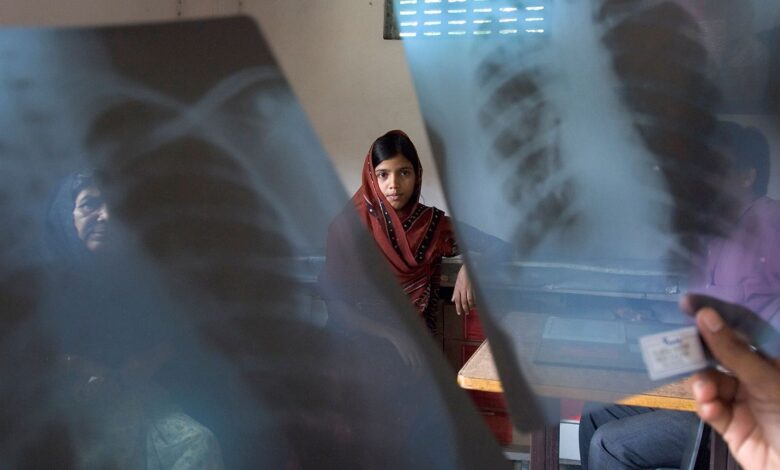Most People With TB Report No Persistent Cough

— Over 80% in multinational analysis lacked hallmark symptom
by
Elizabeth Short, Staff Writer, MedPage Today
March 12, 2024
A significant proportion of people in the community with pulmonary tuberculosis (TB) have subclinical disease, according to a meta-analysis involving survey studies across Africa and Asia.
In adjusted analyses, 82.8% (95% CI 78.6-86.6) of participants with TB reported no persistent cough and 62.5% (95% CI 56.6-68.7) reported no cough at all, according to Frank Cobelens, MD, MSc, PhD, of the Amsterdam Institute for Global Health and Development, and colleagues from the scTB Meta Investigator Group.
Furthermore, the findings in Lancet Infectious Disease showed, 27.7% (95% CI 21.0-36.4) of participants with TB reported no symptoms suggestive of the disease at all, including cough, chest pain, fever, night sweats, or weight loss.
“A persistent cough is often the entry point for a diagnosis, but if 80% of those with TB don’t have one, then it means that a diagnosis will happen later — possibly after the infection has already been transmitted to many others — or not at all,” Cobelens said in a press release.
“Our results indicate the probable reason why, despite huge efforts to diagnose and treat the disease, the [TB] burden across Africa and Asia is hardly declining,” he added. “It’s clear that current practice, especially in the most resource-poor settings will miss large numbers of patients with TB. We should instead focus on x-ray screening and the development of new inexpensive and easy-to-use tests.”
The meta-analysis included data from a dozen surveys conducted in four Asian and eight African nations with high TB incidence over the past 2 decades, ultimately including more 600,000 individuals, 1,944 of whom had TB.
Of the participants with TB, 29.1% (95% CI 25.2-33.3) of those without a persistent cough and 23.1% (95% CI 1.8-27.4) of those without any cough had positive sputum smears, suggesting infectiousness, the study authors noted. The research team also found that TB without cough occurred more frequently among women versus men, though cautioned it’s “possible that men with subclinical tuberculosis participated less often in the surveys (e.g., by being away for work).”
In the U.S., more than 8,000 cases of the deadly infection were reported in 2022, a 5.9% increase versus the prior year, according to the CDC, and an estimated 13 million people are living with latent infections.
Reynold Panettieri Jr., MD, of the Rutgers Institute for Translational Medicine and Science in New Brunswick, New Jersey, who was not involved in the study, said that individual factors such as a patient’s immune status or even nutrition can play a role in how TB symptoms manifest.
“There are people who are immune-compromised where the infection could continue, but not cause, many symptoms because their immune system isn’t fighting the infection,” he told MedPage Today. “They’re infectious, their cough or sneezing may bring up tuberculin, but they may not have had symptoms because they have no inflammation.”
Panettieri encouraged frequent TB testing through purified protein derivative (PPD) skin testing or blood testing when suspicion arises, particularly following direct exposure or if a patient is immunocompromised.
Study Details
Data from the analysis came from 12 of 31 eligible surveys conducted in Cambodia, Ghana, Laos, Lesotho, Nigeria, Pakistan, South Africa, Sudan, Gambia, Uganda, Vietnam, and Zambia that reported pulmonary TB prevalence and symptom screening from 2007 to 2020. Studies that primarily included children, pregnant people, people living with HIV, incarcerated people, migrants, and household contacts of TB patients were excluded.
A majority of the 602,863 participants were from Africa, 57.6% were women, nearly 60% lived in rural areas, and roughly half were under the age of 35. TB screening was conducted via chest x-ray, while symptoms were self-reported. Screening and diagnostic criteria were standardized across the surveys, and TB was defined by positive sputum culture.
Models adjusted for age, sex, and urban versus rural settings.
The researchers examined three definitions of subclinical disease:
- No persistent cough: positive sputum culture but no cough lasting 2 weeks or more prior to screening
- No cough: positive culture but no cough of any duration
- No symptoms: positive culture but no cough, fever, chest pain, night sweats, or weight loss
Cobelens and co-authors stressed that the primary study limitation was that the regression models used did not account for “HIV status, smoking, or indicators of socioeconomic status, because these data were not available for all surveys.” They also noted the small number of surveys ultimately used in the analysis.
-
![author['full_name']](https://clf1.medpagetoday.com/media/images/author/EShort_188.jpg)
Elizabeth Short is a staff writer for MedPage Today. She often covers pulmonology and allergy & immunology. Follow
Disclosures
The study was supported by the Mr Willem Bakhuys Roozeboom Foundation.
Cobelens and co-authors, as well as Panettieri, disclosed no relationships with industry.
Primary Source
The Lancet Infectious Disease
Source Reference: Stuck L, et al “Prevalence of subclinical pulmonary tuberculosis in adults in community settings: an individual participant data metaanalysis” Lancet Infect Dis 2024; DOI:10.1016/ S1473-3099(24)00011-2.

